劳氏船级社压载水管理指南
01 - BWM Convention 压载公约

MEPC.252(67) BWM.2/Circ.42/Rev.1
PSC Guidelines for BWM was adopted at MEPC 67, to be used in association with BWM.2/Circ.42/Rev.1 – Sampling and Analysis Guidance for Trial Use
Seriously affecting human health, cause damage to local aquatic life and local economies 严重地影响人类建康,破坏当地水中生物,环境生态,与地区经济
The effects costs millions of dollars to deal with each year 从而带来每年千万美元以上的损失
Implementation dates in BWM 2004 are different, and part of contents are not relevant, hence A.1088(28) need to be amended, so as BWM 2004 in due course
Management System (AMS) – as of 19 May 2016 到 2016年 5月 19日,USCG接受了57 套压载水处理系统为“替代处理系统” (AMSor IMO type approved BWTS: using UV technology – 27, using electrolysis – 16 得到 IMO 型式认可的BWTS : 使用紫外线 – 27,使用电解 – 16
Xian Dong ZHANG
张晓东
压载水操作须知

压载水操作须知1、船舶压载水操作是为了调整船舶吃水、保持船舶稳性、改善船体受力状态而进行的一项作业,必须规范其操作,以保护环境,保障船舶安全。
1.1、遵守船舶压载水及沉积物管理的规定和有关法律、法规,按相关要求进行压在说的排放、置换作业。
1.2、船长就收集。
整理和更新相关压载水管理信息、资料、特别是所到港口地区的特殊规定或要求,及时对船舶相关岗位人员进行培训,部署和组织落实。
1.3、大副应严格执行计算和校核具体操作方案,确保各项作业符合国家法规、标准、主管机关和港口的规定;确保每一个作业环节都满足稳性、强度等要求。
1.4、大副负责船舶压载水的具体管理工作,并按要求做好抵港压载水申报工作。
1.5、水手长负责按大副指令执行压载水的注/排、换舱和水舱测量操作。
1.6、管轮负责执行大副指令,操作并定期检查和保养泵浦及系统。
1.7、甲板部与轮机部要确保信息沟通准确规范1.8、水手长应按大副指令通知管轮具体的注/排水作业,作业时保持与管轮和大副的沟通,确保各项操作准确无误,要勤测水位,避免压在泵空转或水从空气管溢出,以防造成其它事故。
1.9、管轮和水手长应估算作业完成时间,若水位变化超出预定时应急停泵,及时查明原因和解决问题。
1.10、高边柜或水线上压载水柜智能用泵压载,故更要勤测水位,水手长和管轮要及时转换压载舱或调整速率,以低速率完成所剩容积的压载工作。
1.11、管轮按照大副指令,准确操作压载泵及有关阀门,与水手长保持联系,若有任何疑问应及时查询清楚。
1.12、注/排或置换压载水作业完成后,大副要把压载水的作业时间、数量、舱位、船位等记录在航行日志上。
1.13、管轮负责压载系统的日常维护保养工作,必须保持设备设施处于良好使用状态,防止不能正常排水影响装货和船期。
2、压、排水注意事项2.1、船舱压/排水,注意自由液面对船舶稳性和船舱壁的影响,以安全为前提,选择适当时机进行,压载或排放时,打开透气孔和道门,避免船体和舱盖变形。
船舶压载水管理系统现状及进展研究
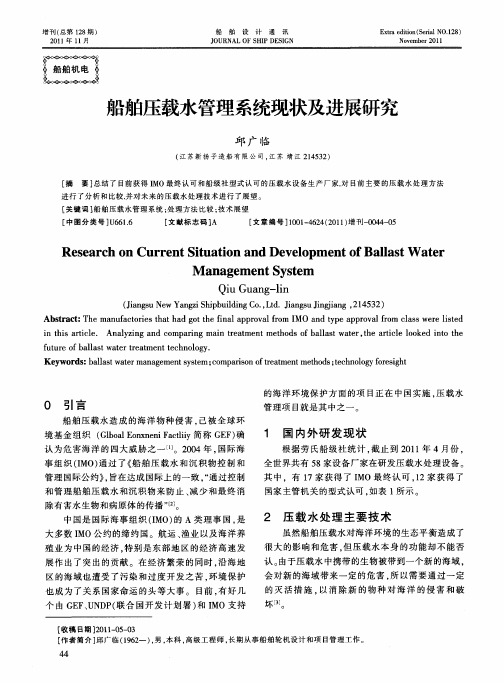
2 1 年 l 月 01 1
船
舶
设
计ห้องสมุดไป่ตู้
通
讯
E t dt n S r lN .2 ) xr e i o ( ei O 1 8 a i a
No e e 01 v mb r2 1
J 0URNAL OF S P S GN HI DE I
船舶压载水管理系统现状及进展研究
会 对 新 的海域 带 来一 定 的危 害 , 以需要 通 过一 定 所 的 灭 活 措 施 . 消 除 新 的物 种 对 海 洋 的侵 害 和 破 以
坏[。
[ 稿 日期 】0 1 0 — 3 收 2 1— 5 0 [ 者 简 介 ] 广 临 (9 2 ) 男 , 科 , 级 工 程 师 , 期 从 事 船 舶 轮机 设 计 和 项 目管理 工 作 。 作 邱 16 一 , 本 高 长
大多 数 I MO公 约 的缔 约 国。航 运 、 业 以及海 洋 养 渔
殖业 为 中 国 的经济 , 别 是东 部 地 区 的经 济 高速 发 特
展作 出了 突 出的贡 献 。在 经 济 繁荣 的 同 时 , 沿海 地 区的海 域 也遭 受 了污 染 和过 度 开发 之苦 , 环境 保 护 也 成 为 了关 系 国家命 运 的头 等 大事 。 目前 , 有好 几 个 由 G F U D ( 合 国开 发计 划 署 ) I 支持 E 、N P 联 和 MO
[ 图分类号 】6 1 中 U6. 6
[ 献标 志 码 ] 文 A
[ 章 编 号 ]0 1 42 (0 1 增 刊 一 0 4 0 文 10 — 6 4 2 1 ) 04 — 5
Re e r h o r e tS t a i n a d De eo m e t f l s a e s a c n Cu r n iu to n v l p n l t o Ba a W t r M a a e e t y tm n g m n se S
英国劳氏船级社船舶入级规范和规则

英国劳氏船级社船舶入级标准和规那么第4章铸钢件第1节一般规定1.1 范围本节对拟用于制造船舶、其它海洋构造物、机械、锅炉、受压容器和管系的铸钢件作出一般规定。
凡涉及设计和建造的关于本标准中规定的铸件制造和试验均应符合第1和第2章的规定,以及本节的一般规定和第2节至第9节中适用的详细规定。
第1章的规定执行。
对于大量消费的小型铸件或定量消费的同型铸件,可以根据的规定,采取变通的检验方法。
1.2 制造铸钢件应在英国劳氏船级社认可的铸造厂制造。
所用钢料的制造程序应经英国劳氏船级社认可。
为除去多余金属而采用的火焰切割、火焰清理或电弧气刨等各种方法,均应按公认的优良工艺,并应在最终热处理之前进展。
凡铸件因其化学成分和/或厚度而有必要预热之处,均应预热。
其受影响的区域应用机加工或打磨平整至约2mm的深度,除非它显示钢材并未由于切割方法而受损害。
切割外表有必要作特别检查,以便发现任何裂缝。
如用焊接方法把两个或多个铸件连接成一个组合构件,应提交拟用的焊接程序细节以供认可。
并要求进展焊接程序的认可试验,也见的规定。
1.3 铸件质量所有铸件不应有不利于正常使用的外表或内部缺陷。
外表光洁度应符合良好的工艺标准和经认可的技术条件的专门要求。
铸件外表不得用锤击、冷锻,也不得用任何可能掩盖缺陷的方法进展处理。
所有芯撑的位置应于注明并应作近观检查〔如有需要,还应进展超声波检测〕,以保证溶透。
1.4 化学成分所有铸件应采用镇静钢制造。
桶样化学成分应在本章有关节中所规定的范围之内。
在规定了通用的总范围的情况下,化学成分应与铸件的钢号、尺度和所要求的力学性能相适应。
除另有规定外,制造商可自行决定选用适宜的晶粒细化元素。
这类元素的含量应在桶样分析报告中列出。
1.5 热处理所有铸件应按本章有关节中的要求进展热处理。
热处理应在构造适宜的炉内进展。
该炉应能有效地维护,并备有适宜的温度控制手段,且设有高温计以测量和记录炉内的装料温度。
炉的尺度应能允许炉内装料能均匀地加热至需要的温度,应有足够数量的热电偶与炉内装料相连,以显示其温度适当均匀并在整个热处理过程中能将温度记录下来。
压载水管理及航运基础知识-普及版

建造日期压载水容量(Cap )船型/吨位标准执行日期压载水置换标准*1)2016年Cap.<1,500m3液货船:DWT<3400散货船:DWT<4200杂货船:DWT<4100或压载水性能标准*2)以前*3)压载水性能标准*2)2017年或以后*3)液货船:压载水置换标准*1)前现有船2009年以前1500m3≤Cap.≤5000m33400<DWT<15000散货船:4200<DWT<14200杂货船:4100<DWT<14000或压载水性能标准*2)2014年以*3)压载水性能标准*2)2015年或以后*3)压载水置换标准*1Cap.>5,000m3液货船:DWT>15000散货船:DWT>14200杂货船:DWT>140001)或压载水性能标准*2)2016年以前*3)压载水性能标准*2)2017年或以后*3)液货船:DWT<15000新船2009年或以后Cap.<5,000m3DWT 15000散货船:DWT<14200杂货船:DWT<14000压载水性能标准*2)2009年或以后2009年或以后,Cap.≥5,000m3液货船:DWT>15000散货船:DWT>14200压载水置换标准*1)或压载水性能标准*2)2016年以前但2012年以前杂货船:DWT>14000压载水性能标准*2)2017年或以后2012年或以后Cap.≥5,000m3全部压载水性能标准*2)2012年或以后主流技术:1、电解法(14家);1电解法(14家)2、紫外线方法(13家)N IMO (G9)形式认证(G8)O.产品名称制造商处理方式基本认证最终认证认证国1Pure Ballast Alfa laval Tumba AB(瑞典)过滤器+UVMEPC56MEPC56挪威*2SEDNA Haman AG/Degussa GmbH (德国)过滤器+杀菌剂MEPC54MEPC57德国*3ELECTRO CLEEN TECHCROSS INC.(韩国)电解次亚+中和剂MEPC54MEPC58韩国*4Oceansaver ballast water Management SystemOCEAN Saver AS(挪威)过滤器+脱氧(N2)+电解次亚+中和剂MEPC57MEPC58挪威5CleanBallast!RWO GmbH Marine WaterTechnology(德国)过滤器+电解次亚+中和剂MEPC55MEPC59德国6NKO3 Blue BallastSystem NK Co.Ltd., (韩国)臭氧MEPC56MEPC59韩国Hitachi Plant Technologies 7日立压载水水净化系统Hitachi Plant Technologies ,Ltd (日本)凝集剂+磁气分离MEPC57MEPC59日本8Greenship BWMS Greenship Ltd.(荷兰)过滤器++电解次亚MEPC58MEPC59PANASIA CO LTD (9GloEn-Patrol PANASIA CO., LTD.(韩国)过滤器+UVMEPC57MEPC60韩国10JFE-BWMS(JFE BallastAce)JFE 工程技术(株)TG 东亚合成过滤器+制剂次亚+中和剂MEPC58MEPC6011Resource Ballast T h l i S t Pesource Ballast Technologies Pty+MEPC57MEPC60Technologies System (Ltd )(南非)过滤器超音波+电解次亚12HHI BWNS(Ecoballast)现代重工(韩国)过滤器+UVMEPC59MEPC6013Hyde Marine USA(美国)过滤器+UVN.A N.A 英国14NEI Treatment SystemUSA(美国)N.AN.A利比里亚在马绍尔群岛g PureBallast系统AOT单元尺寸(高x宽x长)重量(kg)备注PureBallast2502m x0.8m x1m430 kg PureBallast5002m x0.8m x2m860 kg PureBallast10002m x0.8m x4m1720 kg08m2580kg PureBallast15002m x0.8m x6m2580 kg PureBallast20002m x0.8m x8m3440 kgg PureBallast25002m x0.8m x10m4300 kg体积大功率消耗及操作费用(USD/m 3)System Capacity m 3/h Power Consumption NominalOperating Cost $/m 3Hyde Guardian 60110.0183Hyde Guardian 150140.0093Hyde Guardian 250160.0064Hyde Guardian 300240.0080Hyde Guardian 350320.0091Hyde Guardian 400360.0080Hyde Guardian 500480.0064Hyde Guardian 640520.0081Hyde Guardian 750650.0069Hyde Guardian 900850.0058Hyde Guardian 10001000.0052Hyde Guardian12501140.0064It’s simply good business, now!Typical Unitor BWT pipe flow arrangementA Wilh. Wilhelmsen group companyDN Size150200250300350400450500600Flow rate [m³/h]220400600100012001600200025003500[L x 2772 3000 x 3001 x 3201x 3200 x 3200 x 3504 x 3500 x 3500 x DimensionsØmm]x 480x 540x 605x 665x 720x 770x 825x 875 x 995Energy consumption KW7777710101010Pressure difference[bar]<0,5<0,5<0,5<0,5<0,5<0,5<0,5<0,5<0,5Total Weight[Kg]60568581596510851215135517752225杀菌效果好,对环境不会造成污染 维护、使用成本低,经济性好结构紧凑,形式灵活,布置方便 操作简单,维护方便按用途不同,可分为:按用途不同可分为: 干货船液货船工程船。
劳氏船级社发布最新压载水处理技术指南
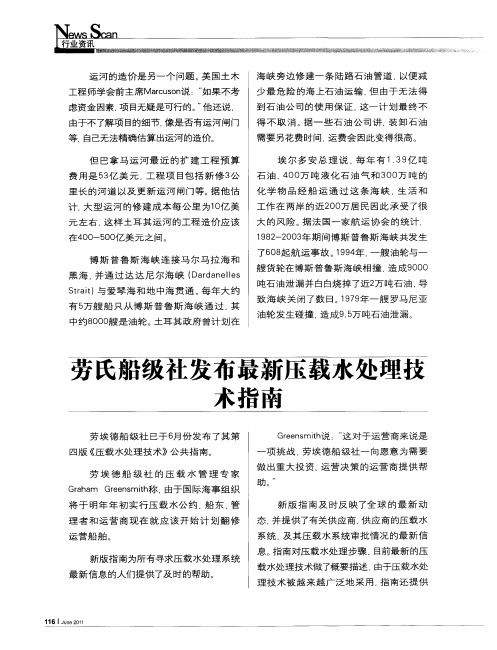
指 南 第二 章 概 述 了有 关强 制执行压 载
水 处 理 的 监 管 规 定 ; 三 章 介 绍 了与压 载 第
水 管 理 有 关的压 载 水处 理 技 术 。 第 二 、 三 章 还 对 这些 压 载 水 技 术 的 第 背 景 和 评 估 情 况做 了介 绍 , 括 它们 的技 包
术特 点 、 测试 情 况 和 审批 状况 。
供 应 商 的详 细资 料 在指 南 的第六 章 .
巴拿马运河 :新船 闸迎百年庆典
为 迎 接 2 1 年 巴 拿 马 运 河 的百 年 庆 04 典 , 河 管 理 局 正 对 这 条 贯 通 大 西 洋 和 运 作 为 闸 门钢 结 构 的供 应 商 , 国现代 韩 重 工 在 2 1 年 底 委 托 博 世 力士 乐 公 司 设 0 0
公 布 的 《 载 水 处 理 系 统 : 舶 经 营 者 采 压 船 购 、 装及 操 作指 南 》中的 “ 安 船东 和管 理 者 实 际指 导 ” 分。 部 此 外 , 三 月号 的 《 运与 环境 》中, 在 航 劳埃 德 船 级社 还 向运 营 商们 提 供 了挑 选 压 载水 处 理 系统 的1 个 步骤 。 O
工程 师学会 前 主席 Macs n :“ r o说 u 如果 不考 虑资金 因素, 目无疑是可行 的。 他 还说 , 项 ”
由于不 了解项 目的细节 , 是 否有 运河 闸门 像
得 不 取 消 。 一 些 石 油 公 司讲 . 卸 石 油 据 装 需 要 另花费 时 间, 运费 会 因此变得 很 高 。 埃 尔 多 安 总 理 说 . 年 有 1 3 亿 吨 每 .9
一
Ge n mi 说 :“ 对 于运 营 商来说 是 re s t h 这
德国劳氏船级社规范
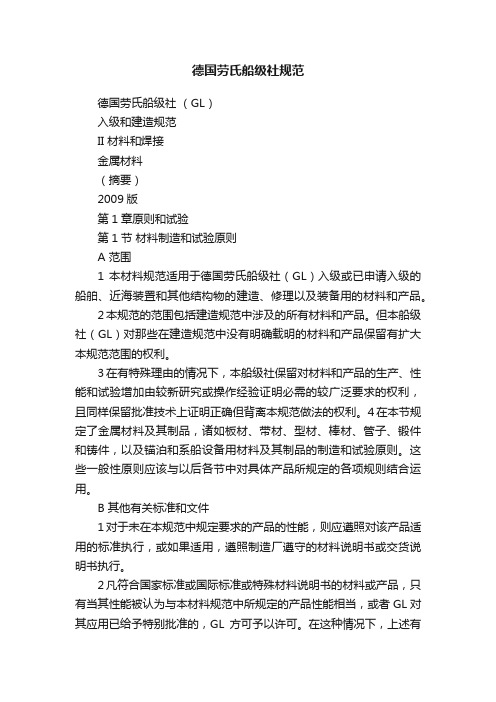
德国劳氏船级社规范德国劳氏船级社(GL)入级和建造规范II 材料和焊接金属材料(摘要)2009版第1章原则和试验第1节材料制造和试验原则A 范围1 本材料规范适用于德国劳氏船级社(GL)入级或已申请入级的船舶、近海装置和其他结构物的建造、修理以及装备用的材料和产品。
2本规范的范围包括建造规范中涉及的所有材料和产品。
但本船级社(GL)对那些在建造规范中没有明确载明的材料和产品保留有扩大本规范范围的权利。
3在有特殊理由的情况下,本船级社保留对材料和产品的生产、性能和试验增加由较新研究或操作经验证明必需的较广泛要求的权利,且同样保留批准技术上证明正确但背离本规范做法的权利。
4在本节规定了金属材料及其制品,诸如板材、带材、型材、棒材、管子、锻件和铸件,以及锚泊和系船设备用材料及其制品的制造和试验原则。
这些一般性原则应该与以后各节中对具体产品所规定的各项规则结合运用。
B 其他有关标准和文件1对于未在本规范中规定要求的产品的性能,则应遵照对该产品适用的标准执行,或如果适用,遵照制造厂遵守的材料说明书或交货说明书执行。
2凡符合国家标准或国际标准或特殊材料说明书的材料或产品,只有当其性能被认为与本材料规范中所规定的产品性能相当,或者GL对其应用已给予特别批准的,GL方可予以许可。
在这种情况下,上述有关标准或规范可被认为是本规范的一个组成部分。
3根据上述第2条规定的条件,GL可允许提供只符合有关标准或材料规格的产品。
4如果本规范与其他有关标准或说明书之间在要求上有不同时,则试验应以较高的要求为准。
C 对制造厂的要求1凡是本规范所述及的材料和产品,只有经本船级社认可的工厂才能进行制造。
为取得船级社的认可,制造厂应至少满足下列条件,并在工厂检验期间向本船级社提交能满足这些条件的证明以及在开始生产以前提交相应的文件:1.1制造厂应配备能够专门制造和加工出符合现代技术规格的材料的各种设备。
1.2为了能够按照本材料规范和其他有关文件所规定的试验规程熟练进行检验,制造厂应配置必需的试验设备和拥有操作这些设备的熟练技术人员。
简明海事执法英语(2)
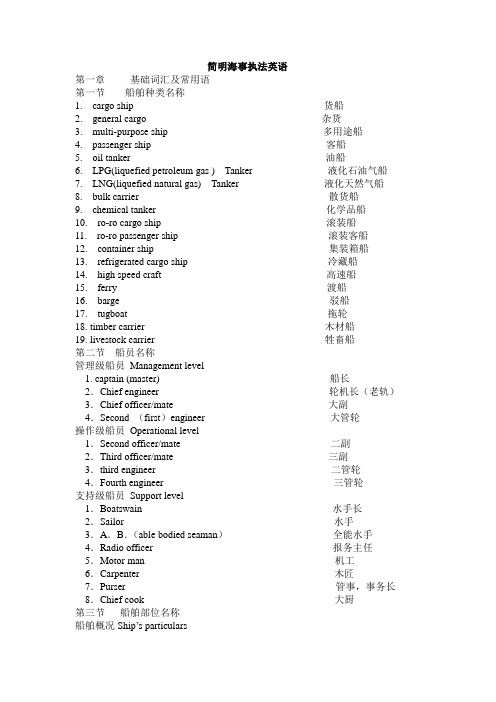
简明海事执法英语第一章基础词汇及常用语第一节船舶种类名称1. cargo ship 货船2. general cargo 杂货3. multi-purpose ship 多用途船4. passenger ship 客船5. oil tanker 油船6. LPG(liquefied petroleum gas ) Tanker 液化石油气船7. LNG(liquefied natural gas) Tanker 液化天然气船8. bulk carrier 散货船9. chemical tanker 化学品船10. ro-ro cargo ship 滚装船11. ro-ro passenger ship 滚装客船12. container ship 集装箱船13. refrigerated cargo ship 冷藏船14. high speed craft 高速船15. ferry 渡船16. barge 驳船17. tugboat 拖轮18. timber carrier 木材船19. livestock carrier 牲畜船第二节船员名称管理级船员Management level1. captain (master) 船长2.Chief engineer 轮机长(老轨)3.Chief officer/mate 大副4.Second (first)engineer 大管轮操作级船员Operational level1.Second officer/mate 二副2.Third officer/mate 三副3.third engineer 二管轮4.Fourth engineer 三管轮支持级船员Support level1.Boatswain 水手长2.Sailor 水手3.A.B.(able bodied seaman)全能水手4.Radio officer 报务主任5.Motor man 机工6.Carpenter 木匠7.Purser 管事,事务长8.Chief cook 大厨第三节船舶部位名称船舶概况Ship’s particulars1.ship’s name 船名2.LOA (length overall)总长3.breadth 型宽4.depth 型深5. max. height from keel 龙骨以上最大高度6.call sign 呼号7.horse power 主机功率8.speed 航速9.type 种类10.when built 建造年月11.summer full load draft 夏季满载载重线12.fresh water allowance 吃水余量13.TPC(tonnes per centimeter immersion)吨、厘米吃水14.DWT(dead weight tonnage) 载重吨位15.TEU(twenty feet equivalent unit 20) 20英尺标准箱16.IMO number IMO 编号17.ship owner 船东18.operator 经营人19.trim 纵倾20.list 横倾21.port side 左舷22.starboard side 右舷23.longitudinal 纵向24.transverse 横向25.horizontal 水平26.vertical 垂直27.centre line 中心线甲板概况Deck’s particulars1.bow/fore 船首2.stern/aft 船尾3.keel 龙骨4.bottom shell plate 船底外板5.side shell plate 舷侧外板6.frame 肋骨7.man hole 人孔8.collision bulkhead 防撞舱壁9.chain compressor 制链器10.chain locker 锚链舱11.rat guard 挡鼠板12.rope/line 缆绳13.handrail 栏杆14.accommodation ladder 舷梯15.rope ladder 软梯16.scuttle 舷窗17.sky light 天窗18.free board 干舷19.draft mark 吃水标志20.main mast 主桅21.load line mark 载重线标志22.fore mast 前桅23.after derrick post/king post 后桅24.bridge 驾驶台25.funnel 烟囱26.radar mast 雷达桅27.derrick boom 吊杆28.ventilator 通风筒29.wire 钢缆30.capstan 绞盘31.gangway/gangway board 舷梯/上下面船跳板32.mooring winch 绞缆机33.windlass 锚机机舱概况Engine room’s particulars1. incinerator 焚化装置,焚烧炉2. sludge 沉淀物,淤积物3. waste 废物,垃圾4. purifier 滤清器,净化器,清洁器5. bilge 舱底污水6. separator 分离器7. filter 过滤器,过滤8. sewage 生活污水9. fuel oil tank 燃油舱10. daily tank 日用柜11. settling tank 沉淀柜12. lubricating oil 润滑油13. cylinder 汽缸14. piston 活塞15. auxiliary engine/auxiliary machinery 辅机16. cooling water 冷却水17. boiler 锅炉19. steering gear 操舵装置,舵机20. emergency generator 应急发电机21. rudder 舵22. propeller 螺旋桨23. helm 舵轮第四节其他常用词汇时间Time1. year 年2. month 月3. day 日4. hour (h./hr.) 小时5. minute (min.) 分钟6. second (sec.)秒长度Length1. metre (m)米2. decimeter (dm)分米3. centimeter (cm)厘米4. millimeter (mm)毫米5. kilometer (km) 千米6. foot,feet 英尺7. sea mile, nautical mile(n mile) 海里8. knot (kn) 节月份Month1. January (Jan.)一月2. February (Feb.) 二月3. March (Mar.) 三月4. April (Apr.) 四月5. May (May) 五月6. June (Jun.) 六月7. July (Jul.) 七月8. August (Aug.) 八月9. September (Sept.) 九月10. October (Oct.) 十月11. November (Nov.) 十一月12. December (Dec.) 十二月星期Week1. Monday (Mon.) 星期一2. Tuesday (Tue.,Tues.) 星期二3. Wednesday (Wed.) 星期三4. Thursday (Thu.) 星期四5. Friday (Fri.) 星期五6. Saturday (Sat.) 星期六7. Sunday (Sun.) 星期日第五节与船员的简单对话与甲板值班船员对话1. How do you do? (How are you?) 你好!2. I am fine, thank you. 我很好,谢谢!3. I’m very glad to meet you. 很高兴见到你4. Hello, good morning! 早上好!5. Good afternoon. 下午好!6. Good evening. 晚上好!7. Who are you? 你的身份?8. We are officers from MSA. 我们是海事官员。
2012年1月起生效的船舶公约规范规则及修正案(word版)
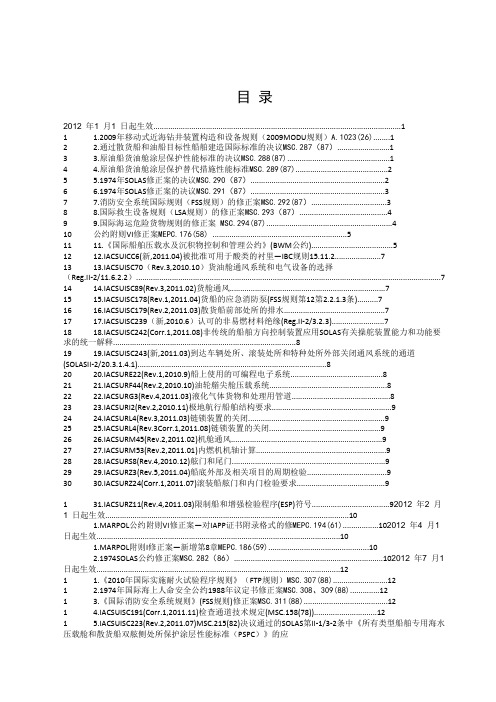
目录2012 年1 月1 日起生效 (1)1 1.2009年移动式近海钻井装置构造和设备规则(2009MODU规则)A.1023(26) (1)2 2.通过散货船和油船目标性船舶建造国际标准的决议MSC.287(87) (1)3 3.原油船货油舱涂层保护性能标准的决议MSC.288(87) (1)4 4.原油船货油舱涂层保护替代措施性能标准MSC.289(87) (2)5 5.1974年SOLAS修正案的决议MSC.290(87) (2)6 6.1974年SOLAS修正案的决议MSC.291(87) (3)77.消防安全系统国际规则(FSS规则)的修正案MSC.292(87) (3)88.国际救生设备规则(LSA规则)的修正案MSC.293(87) (4)99.国际海运危险货物规则的修正案 MSC.294(87) (4)10公约附则VI修正案MEPC.176(58) (5)1111.《国际船舶压载水及沉积物控制和管理公约》(BWM公约) (5)1212.IACSUICC6(新,2011.04)被批准可用于酸类的衬里—IBC规则15.11.2 (7)1313.IACSUISC70(Rev.3,2010.10)货油舱通风系统和电气设备的选择(Reg.II‐2/11.6.2.2) (7)1414.IACSUISC89(Rev.3,2011.02)货舱通风 (7)1515.IACSUISC178(Rev.1,2011.04)货船的应急消防泵(FSS规则第12第2.2.1.3条) (7)1616.IACSUISC179(Rev.2,2011.03)散货船前部处所的排水 (7)1717.IACSUISC239(新,2010.6)认可的非易燃材料绝缘(Reg.II‐2/3.2.3) (7)1818.IACSUISC242(Corr.1,2011.08)非传统的船舶方向控制装置应用SOLAS有关操舵装置能力和功能要求的统一解释 (8)1919.IACSUISC243(新,2011.03)到达车辆处所、滚装处所和特种处所外部关闭通风系统的通道(SOLASII‐2/20.3.1.4.1) (8)2020.IACSURE22(Rev.1,2010.9)船上使用的可编程电子系统 (8)2121.IACSURF44(Rev.2,2010.10)油轮艏尖舱压载系统 (8)2222.IACSURG3(Rev.4,2011.03)液化气体货物和处理用管道 (8)2323.IACSURI2(Rev.2,2010.11)极地航行船舶结构要求 (9)2424.IACSURL4(Rev.3,2011.03)链锁装置的关闭 (9)2525.IACSURL4(Rev.3Corr.1,2011.08)链锁装置的关闭 (9)2626.IACSURM45(Rev.2,2011.02)机舱通风 (9)2727.IACSURM53(Rev.2,2011.01)内燃机机轴计算 (9)2828.IACSURS8(Rev.4,2010.12)舷门和尾门 (9)2929.IACSURZ3(Rev.5,2011.04)船底外部及相关项目的周期检验 (9)3030.IACSURZ24(Corr.1,2011.07)滚装船舷门和内门检验要求 (9)131.IACSURZ11(Rev.4,2011.03)限制船和增强检验程序(ESP)符号.....................................92012 年2 月1 日起生效.. (10)1.MARPOL公约附则VI修正案—对IAPP证书附录格式的修MEPC.194(61).................102012 年4 月1 日起生效.. (10)1.MARPOL附则I修正案—新增第8章MEPC.186(59) (10)2.1974SOLAS公约修正案MSC.282(86).......................................................................102012 年7 月1 日起生效.. (12)1.《2010年国际实施耐火试验程序规则》(FTP规则)MSC.307(88) (12)2.1974年国际海上人命安全公约1988年议定书修正案MSC.308、309(88) (12)3.《国际消防安全系统规则》(FSS规则)修正案MSC.311(88) (12)4.IACSUISC191(Corr.1,2011.11)检查通道技术规定(MSC.158(78)) (12)5.IACSUISC223(Rev.2,2011.07)MSC.215(82)决议通过的SOLAS第II‐1/3‐2条中《所有类型船舶专用海水压载舱和散货船双舷侧处所保护涂层性能标准(PSPC)》的应用 (13)6.IACSUISC244(新,2011.05)救生艇主要释放装置艇钩的负荷试验(IMORes.MSC.81(70),Part2,Ch.5.3.4) (13)7.IACSUISC245(新,2011.06)应急消防泵穿过机器处所的吸入管(SOLASII‐2/10.2.1.4.1) (1)38.IACSUISC246(新,2011.06)舵机试验 (13)9.IACSUISC247(新,2011.09)开放式甲板应急舱口盖(SOLASReg.II‐2/13.1) (13)10.IACSUISC249(新,2011.10)执行SOLASII‐1,Regulation3‐5andMSC.1/Circ.1379 (13)11.IACSUISC250(新,2011.10)货舱消防设备(Res.MSC.268(85),IMSBCCode) (13)12.IACSUISC252(新,2011.10)二氧排放控制及保护处所警报激活(FSSCode5.2.2.2)1413.IACSURM42(Rev.4,2011.06)舵机 (14)14.IACSURS21A(新,2011.05)舱口盖、舱口围板及货船关闭装置船材尺寸估算 (14)15.IACSURS21A(Corr.1,2011.10)舱口盖、舱口围板及货船关闭装置船材尺寸估算.1416.IACSURZ7(Rev.19,2011.06)船体入级检验 (14)17.IACSURZ7.1(Rev.7,2011.07)一般干货船船体入级检验 (14)18.IACSURZ7.2(Rev.3,2011.06)液化气体船船体检验 (14)19.IACSURZ10.1(Rev.18,2011.03)油船船体检验 (14)20.IACSURZ10.2(Rev.28,2011.03)散货船船体检验 (14)21.IACSURZ10.3(Rev.12,2011.03)化学船船体检验 (15)22.IACSURZ10.3(Rev.13,2011.07)化学船船体检验 (15)23.IACSURZ10.4(Rev.10,2011.07)双壳体油船船体检验 (15)24.IACSURZ10.5(Rev.10,2011.03)双壳体散货船船体检验 (15)25.IACSURZ10.5(Rev.11,2011.07)双壳体散货船船体检验.............................................152013 年1 月1 日起生效.. (15)1.1974年SOLAS修正案的决议MSC.291(87) (15)2.经修正的《1974年国际海上人命安全公约》修正案MSC.317(89) (15)3.《国际海运固体散装货物规则》(IMSBCCode)修正案MSC.318(89) (16)4.《国际救生设备规则》((LSACode)修正案MSC.320(89) (16)5.MARPOL附则IV修正案——指定波罗的海为特殊区域MEPC.200(62) (16)6.MARPOL附则V修正案(经修订的MARPOL附则V)MEPC.201(62) (16)7.MARPOL附则VI修正案(第13条和14条以及附录VII的修订)MEPC.202(62) (17)8.MARPOL附则VI修正案(引入船舶能效条款)MEPC.203(62) (17)9.IACSURZ7.1(Rev.8,2011.10)一般干货船船体检验 (17)10.IACSUISC251(新,2011.10)周期性无人值班机舱内应急舱底吸入阀的控制(SOLASII‐1/48.3)..........................................................................................................................172013 年7 月1 日起生效.. (18)1.1974SOLAS公约修正案MSC.282(86) (18)1 2.通过1974年SOLAS修正案的决议MSC.291(87)....................................................182013 年9 月27 日起生效 (18)1.MARPOL公约附则IV—防止船舶生活污水污染规则....................................................182014 年1 月1 日起生效.. (18)1.经修订的MARPOL公约附则III MEPC.193(61) (18)2 2.《国际船舶压载水及沉积物控制和管理公约》(BWM公约).....................................192014 年7 月1 日起生效.. (19)3 1.1974SOLAS公约修正案MSC.282(86).......................................................................192015 年1 月1 日起生效.. (19)1.MARPOL公约附则VI修正案MEPC.176(58) ................................................................192015 年7 月1 日起生效.. (19)1.1974SOLAS公约修正案MSC.282(86) (19)2.关于与SOLAS规则II‐2/12要求的等效喷淋系统认可导则的修正案(第A.800(19)号决议MSC.284(86).........................................................................................................202016 年1 月1 日起生效.. (20)1 1.通过1974年SOLAS修正案的决议MSC.291(87) (20)2 2.MARPOL公约附则VI修正案MEPC.176(58) (20)3.《国际船舶压载水及沉积物控制和管理公约》(BWM公约)......................................212016 年7 月1 日起生效.. (21)1.1974SOLAS公约修正案MSC.282(86) (21)2.通过1974年SOLAS修正案的决议MSC.290(87)....................................................212017 年7 月1 日起生效.. (21)1.1974SOLAS公约修正案MSC.282(86) (21)2 2.通过1974年SOLAS修正案的决议MSC.290(87)....................................................212018 年7 月1 日起生效.. (22)3 1.1974SOLAS公约修正案MSC.282(86).......................................................................222020 年1 月1 日起生效.. (22)4 1.MARPOL公约附则VI修正案MEPC.176(58) ................................................................222020 年7 月1 日起生效.. (22)1.通过1974年SOLAS修正案的决议MSC.290(87) (22)2012 年1 月1 日起生效1. 2009 年移动式近海钻井装置构造和设备规则(2009MODU 规则)A.1023(26)2009年移动式移动式近海钻井装置构造和设备规则(2009 MODU CODE) IMO 最早于1979 年以A.414(XI)决议案采纳移动式外海探勘装置的结构与设备章程,后于1989 年以A.649(16)决议案予以修正,本次大会又采纳A.1023(26)决议案,取代A.649(16),并适用于2012年1月1日以后安放龙骨者。
压载水技术:争奇斗艳 殊途同归
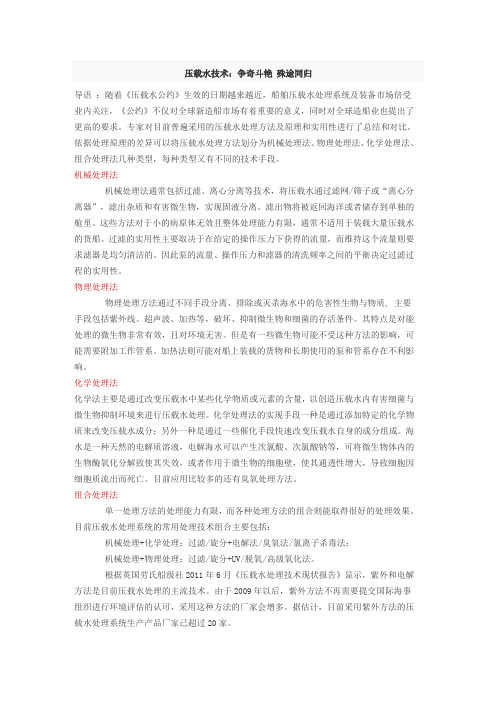
压载水技术:争奇斗艳殊途同归导语:随着《压载水公约》生效的日期越来越近,船舶压载水处理系统及装备市场倍受业内关注,《公约》不仅对全球新造船市场有着重要的意义,同时对全球造船业也提出了更高的要求。
专家对目前普遍采用的压载水处理方法及原理和实用性进行了总结和对比。
依据处理原理的差异可以将压载水处理方法划分为机械处理法、物理处理法、化学处理法、组合处理法几种类型,每种类型又有不同的技术手段。
机械处理法机械处理法通常包括过滤、离心分离等技术,将压载水通过滤网/筛子或“离心分离器”,滤出杂质和有害微生物,实现固液分离。
滤出物将被返回海洋或者储存到单独的舱里。
这些方法对于小的病原体无效且整体处理能力有限,通常不适用于装载大量压载水的货船。
过滤的实用性主要取决于在给定的操作压力下获得的流量,而维持这个流量则要求滤器是均匀清洁的。
因此泵的流量、操作压力和滤器的清洗频率之间的平衡决定过滤过程的实用性。
物理处理法物理处理方法通过不同手段分离、排除或灭杀海水中的危害性生物与物质, 主要手段包括紫外线、超声波、加热等,破坏、抑制微生物和细菌的存活条件。
其特点是对能处理的微生物非常有效,且对环境无害。
但是有一些微生物可能不受这种方法的影响,可能需要附加工作管系。
加热法则可能对船上装载的货物和长期使用的泵和管系存在不利影响。
化学处理法化学法主要是通过改变压载水中某些化学物质或元素的含量,以创造压载水内有害细菌与微生物抑制环境来进行压载水处理。
化学处理法的实现手段一种是通过添加特定的化学物质来改变压载水成分;另外一种是通过一些催化手段快速改变压载水自身的成分组成。
海水是一种天然的电解质溶液,电解海水可以产生次氯酸、次氯酸钠等,可将微生物体内的生物酶氧化分解致使其失效,或者作用于微生物的细胞壁,使其通透性增大,导致细胞因细胞质流出而死亡。
目前应用比较多的还有臭氧处理方法。
组合处理法单一处理方法的处理能力有限,而各种处理方法的组合则能取得很好的处理效果。
《国际船舶压载水及其沉积物控制和管理公约》
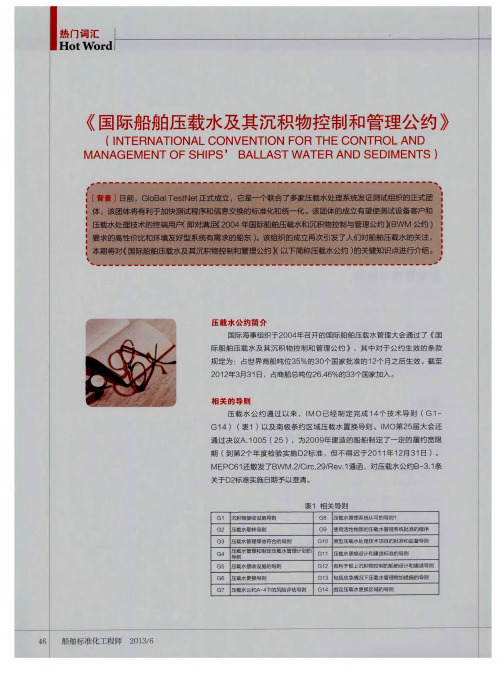
)5 0 0 0 m 2 0 0 9 年1 月1 日~ 2 0 1 0 年1 月1 日 2 0 1 0 年之后 2 0 1 0 年1 月1 q ̄ I 2 0 1 2 年1 月1 日 2 0 1 2 a z 1 月1 日之后 <5 0 0 0 m <5 0 0 0 m >5 0 0 0 m >5 0 0 0 m
2 0 1 6 年1 月1 日之前
2 0 1 6 年1 月1 日开始 2 0 1 2 年1 月1 日开始
4 8
船舶标准化工程师
2 0 1 3 / 6
D2 标 准适 用 的 时间 的解 释 :追 溯 性适 用 ;对 于 不 同年 份建 造 、不 同 压 载水 容量 的船舶 适用 的 时间不 同 ;不优 惠条款 。
D 1 和D 2 标 准适 用的 时间表 ( 表2)
表2 D1 和D 2 标准 适用 的时 间表
建造 日期 压载能力 1 5 0 0 m ~ 5 0 0 0 m 2 0 0 9 年1 月1 日之前
<1 5 00 m
符合Dl 更换标准 2 0 1 4 年1 月1 日之前 2 0 1 6 年1 月1 日之前 2 0 1 2 年1 月1 日之前
符合D2 处理标准 2 0 1 4 年1 月1 日开始 2 0 1 6 年1 月1 日开始 2 0 1 2 年1 月1 日开始 2 0 1 0 年1 月1 日开始
处 ,按 照本组 织制 定 的导则 进行 压载水 更换 。
2) 根据 本条第 1 . 1 款不 能进行 压载 水更 换的 船舶 ,其压 载水 更换须 考
虑第 1 . 1 款 所 述 的导 则进 行 并 尽可 能 地远 离 陆地 ,在 任何 情 况下 距 离最 近
陆地不 得少 于5 0 海 里和 水深 不得 少于2 0 0 米。
劳氏船级社船东船长船舶维护指南检查表
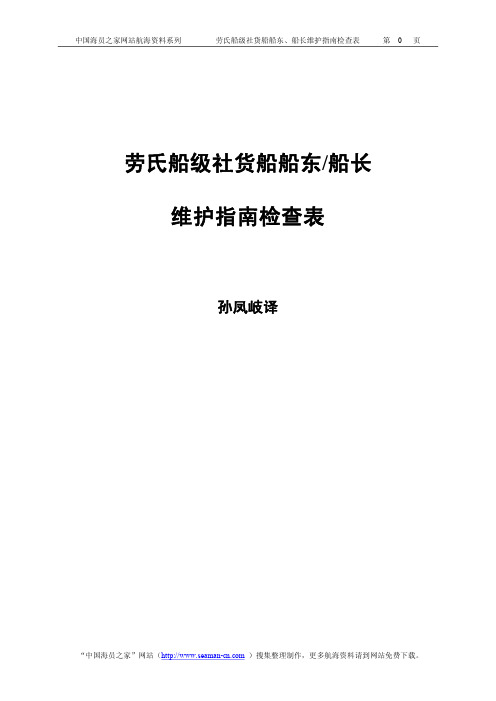
加拿大北极海域防污染法规
USA 汽体排出控制系统
USCG 合格证书
US 油船检查证书
危险货物装货清单或积载图
货物积载和系固手册
固体散装货物安全操作规则
对 92 年 2 月 1 日及以后建造的船舶,备有要求的损坏控制图吗?
法定的记录簿,如果需要携带。
机动操纵手册(在驾驶台存放的资料)
SOLAS、MARPOL 及载重线公约的现行版本
货船无线电设备、无线电报或无线电话安全证书和免除证书,
如果有
设备登记(表格 R)(LR 表格 2131)
经批准的货船无线电装置登记(LR 表格 2116 或 2138)
货船安全证书
运输危险货物符合证明(SOLAS74 规则Ⅱ2/S4)
散装运输液化气适运国际证书或散装运输液化气适运证书
散装运输危险化学品适运国际证书或散装运输危险化学品适运
检查项目 船员数量和编制与安全配员证书一致 船上人员的数目不超过批准的救生设备的安全设备证书所述的 数目 表 6: 生活设施
检查项目 居住舱室、餐厅、医院/病房,清洁和适于居住,无任何侵扰, 以及所有的门能适当关闭。 在寒冷地带有暖气。通风包括便所抽风机在工作。 所有的生活区有充足的照明 卫生间/沐浴间/洗涤间/洗澡间清洁,处于良好的工作状态,供 应热水,无泄漏,无缺陷/破损/设备丢失,去卫生间的门良好。泄水 无堵塞,地板/瓷砖无损坏。 船上没有过多的垃圾 在船员居住处所没有贮存船舶物料和设备 没有把医院用于船员生活舱室 药箱放置适当,有关于药物/设备的使用说明。 表 7: 食品和伙食
-油漆或防锈系统情况,如果有
货物设备
船舶起重设备和货物操作设备,注册(LA.1 或 CG.1(LR 表格
1365))或完成下述适用的等效的国家主管机关表格:
船舶压载水管理计划-全文

船舶压载水管理计划-全文一、背景介绍二、目的本文旨在制定一套科学、合理和可执行的船舶压载水管理计划,以确保船舶良好的运营和管理,并保护环境免受潜在的污染。
三、管理措施2.压载水处理压载水应在进入船舶之前进行适当的处理。
处理方式应符合相关的国际和国内标准,以确保压载水的质量符合要求。
3.压载水质量监测船舶应配备适当的压载水质量监测设备,并定期进行压载水质量检测。
监测数据应记录并保存,以备查阅。
如发现压载水质量不合格,及时采取相应措施进行处理。
4.压载水存储船舶应具备合适的压载水存储设施。
存储仓容量应符合相关要求,并能够确保压载水的安全存储。
存储设施应定期进行检查和维护,以确保其正常运行。
5.压载水使用船舶在使用压载水时应遵循一定的原则和要求。
压载水应根据实际需求进行合理使用,并通过相应的控制措施确保压载水的使用安全可靠。
6.压载水安全管理船舶应建立健全的压载水安全管理制度,并明确责任人和管理流程。
监管部门应定期进行巡查和检查,确保船舶压载水安全管理制度的有效执行。
7.废水处理船舶在处理压载水产生的废水时应依据相关法律法规进行处理。
废水处理工艺应符合国际和国内标准,并定期进行维护和检查,以确保废水的安全排放。
8.应急处置船舶应建立紧急事件应对机制,对可能发生的压载水泄漏等事故做好预案。
一旦发生压载水泄漏等紧急情况,应立即采取相应的应急处置措施,并及时报告有关部门。
四、责任1.所有船舶相关人员应遵守船舶压载水管理计划的相关规定,保证良好的执行。
2.船舶拥有者或经营者应制定并确保船舶压载水管理计划的落实,并承担主要责任。
3.执法机构应加强对船舶压载水管理计划的监管和检查,确保其有效执行。
五、宣传与培训1.船舶相关人员应接受压载水管理知识的培训,提高其对船舶压载水管理的认识和意识。
2.执法机构应加强对船舶压载水管理计划的宣传,提高船舶压载水管理的重要性和紧迫性。
六、总结本船舶压载水管理计划的制定是为了确保船舶压载水的合规性和安全性,并保护环境免受潜在的污染。
劳氏海船入级规范(防火、探火、灭火)

防火、探火和灭火要求第一节通则1.1 适用范围1.1.1 1.2条和本章其它各节的要求适用于小于500总吨的货船(不包括液化气运输船和化学品液货船)、登记长度为12m及以上但干舷长小于45m的渔船和未装设推进机器的船。
这些船均应符合1.2和本章其它各节的要求。
1.1.2 可以考虑采纳由船籍国政府规定的和批准的消防安全措施以代替1.1.1,但这些措施应能提供劳氏船级社可以接受的等级的消防安全性。
1.1.3 对本章没有提及的结构和布置要点应作符合所涉及火灾危险的特殊考虑。
1.1.4 1.2条和本章其它各节的要求不适用于国际航行的500总吨及以上的货船、所有客船、液化气运输船和化学品液货船。
这些船均应装备1974年国际海上人命安全公约和修正案所要求的消防安全措施。
干舷长45m及以上的渔船应装备与1977年Torremolinos国际渔船安全公约相关的1993年Torremolinos议定书要求的消防安全措施。
1.1.5 1.2条和本章其它各节的要求不适用于国内航行的500总吨及以上的货船、所有客船、液化气运输船和化学品液货船。
这些船均应遵守船籍国政府规定的和批准的消防安全措施,但这些措施应能提供劳氏船级社可以接受的等级的消防安全性。
1.1.6 船籍国政府有责任使1.1.4和1.1.5的防火、探火和灭火要求生效,但在下列情况下劳氏船级社将负责使之生效:(a) 签约政府授权劳氏船级社应用1974年国际海上人命安全公约或Torremolinos议定书的要求和代表他们颁发适当的证书;或(b) 船籍国政府不是1974年国际海上人命安全公约或Torremolinos议定书的签约国;或(c) 船舶或渔船已入级为限止或特殊服务于国内水域,且船籍国政府没有国家规定。
在这样情况,劳氏船级社将适当地应用1974年国际海上人命安全公约或Torremolinos议定书要求的消防安全措施。
然而,在注意到限止或特殊服务的环境,提供可接受等级的消防安全的安排将给以适当的考虑。
DNVoGL 船级社发布了有关自主和远程操作的船舶指南
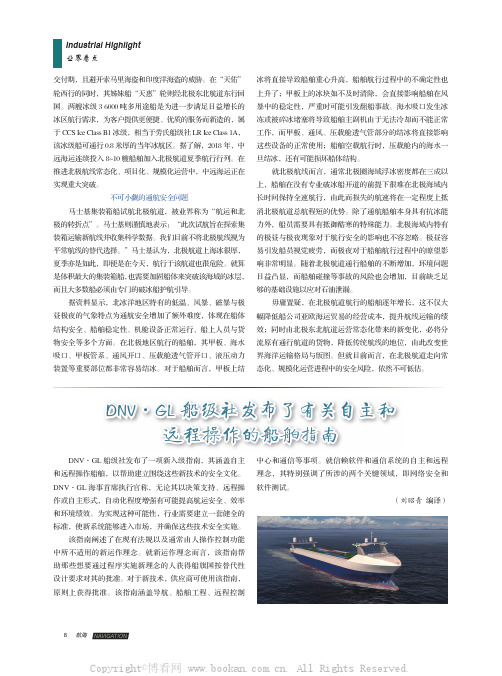
NAVIGATION航海8Industrial Highlight 业界看点DNV·GL 船级社发布了一项新入级指南,其涵盖自主和远程操作船舶,以帮助建立围绕这些新技术的安全文化。
DNV·GL 海事首席执行官称,无论其以决策支持、远程操作或自主形式,自动化程度增强有可能提高航运安全、效率和环境绩效。
为实现这种可能性,行业需要建立一套健全的标准,使新系统能够进入市场,并确保这些技术安全实施。
该指南阐述了在现有法规以及通常由人操作控制功能中所不适用的新运作理念。
就新运作理念而言,该指南帮助那些想要通过程序实施新理念的人获得船旗国按替代性设计要求对其的批准。
对于新技术,供应商可使用该指南,原则上获得批准。
该指南涵盖导航、船舶工程、远程控制DNV·GL 船级社发布了有关自主和远程操作的船舶指南中心和通信等事项。
就信赖软件和通信系统的自主和远程理念,其特别强调了所涉的两个关键领域,即网络安全和软件测试。
(刘昭青 编译)交付期,且避开索马里海盗和印度洋海盗的威胁。
在“天佑”轮西行的同时,其姊妹船“天惠”轮则经北极东北航道东行回国。
两艘冰级3 6000吨多用途船是为进一步满足日益增长的冰区航行需求,为客户提供更便捷、优质的服务而新造的,属于CCS Ice Class B1冰级,相当于劳氏船级社LR Ice Class 1A,该冰级船可通行0.8米厚的当年冰航区。
据了解,2018年,中远海运连续投入8~10艘船舶加入北极航道夏季航行行列。
在推进北极航线常态化、项目化、规模化运营中,中远海运正在实现重大突破。
不可小觑的通航安全问题马士基集装箱船试航北极航道,被业界称为“航运和北极的转折点”。
马士基则谨慎地表示:“此次试航旨在探索集装箱运输新航线并收集科学数据。
我们目前不将北极航线视为平常航线的替代选择。
”马士基认为,北极航道上海冰很厚,夏季亦是如此,即便是在今天,航行于该航道也很危险。
压载水管理系统批准和技术研发现状
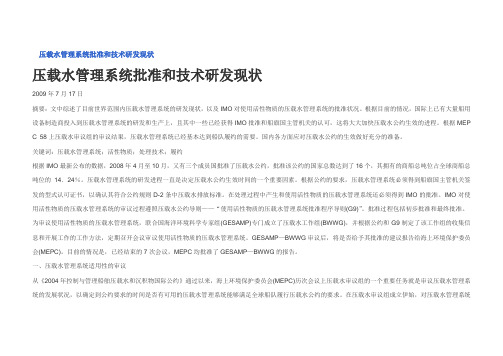
压载水管理系统批准和技术研发现状压载水管理系统批准和技术研发现状2009年7月17日摘要:文中综述了目前世界范围内压载水管理系统的研发现状,以及IMO对使用活性物质的压载水管理系统的批准状况。
根据目前的情况,国际上已有大量船用设备制造商投入到压载水管理系统的研发和生产上,且其中一些已经获得IMO批准和船旗国主管机关的认可,这将大大加快压载水公约生效的进程。
根据MEP C 58上压载水审议组的审议结果,压载水管理系统已经基本达到船队履约的需要。
国内各方面应对压载水公约的生效做好充分的准备。
关键词:压载水管理系统;活性物质;处理技术;履约根据IMO最新公布的数据,2008年4月至10月,又有三个成员国批准了压载水公约,批准该公约的国家总数达到了16个,其拥有的商船总吨位占全球商船总吨位的14.24%。
压载水管理系统的研发进程一直是决定压载水公约生效时间的一个重要因素。
根据公约的要求,压载水管理系统必须得到船旗国主管机关签发的型式认可证书,以确认其符合公约规则D-2条中压载水排放标准。
在处理过程中产生和使用活性物质的压载水管理系统还必须得到IMO的批准。
IMO对使用活性物质的压载水管理系统的审议过程遵照压载水公约导则——“使用活性物质的压载水管理系统批准程序导则(G9)”。
批准过程包括初步批准和最终批准。
为审议使用活性物质的压载水管理系统,联合国海洋环境科学专家组(GESAMP)专门成立了压载水工作组(BWWG),并根据公约和G9制定了该工作组的收集信息和开展工作的工作方法,定期召开会议审议使用活性物质的压载水管理系统。
GESAMP—BWWG审议后,将是否给予其批准的建议报告给海上环境保护委员会(MEPC)。
目前的情况是,已经结束的7次会议,MEPC均批准了GESAMP—BWWG的报告。
一、压载水管理系统适用性的审议从《2004年控制与管理船舶压载水和沉积物国际公约》通过以来,海上环境保护委员会(MEPC)历次会议上压载水审议组的一个重要任务就是审议压载水管理系统的发展状况,以确定到公约要求的时间是否有可用的压载水管理系统能够满足全球船队履行压载水公约的要求。
转载国际船舶规范标准工艺手册汇总

转载国际船舶规范标准工艺手册汇总轮机一、设计教材类1.《船舶设计实用手册》(全套)带书签版中国船舶工业总公司编国防工业出版社2000年第一版2.《民用船舶动力装置》第2版商圣义主编人民交通出版社1996年出版3.《轮机工程手册》(中、下)陈绍纲主编《轮机工程手册》编委会编人民交通出版社,19924.《机械制造手册》辽宁科学技术出版社2002年5.《船舶主推进动力装置船舶柴油机》杜荣铭主编:大连海事大学出版社出版日期:19996.《轮机自动化教案》PPT格式7.《机械设计手册2.0软件版》8.《英国劳氏B&W系列主机轴系校中计算软件》9.《工程力学手册》主编杜庆华等高等教育出版社199410.《船舶管路系统设计大纲》2006.3哈尔滨工程大学出版社付锦云11.《实用阀门设计手册》清华大学房汝洲主编2006二、标准类1.《CSSC管路附件标准VCD》中国船舶工业综合技术经济研究院出版2000版2.《船舶管系布置和安装通用技术条件》3.《船舶管系附件手册》中国交通科技出版社2007年9月4.《最新国际船舶管路色标》(ISO14726-2007Shipsandmarinetechnology)5.《船用阀门标准使用指南》大连造船厂奚基华姜堰市船用阀门厂郭云章三、设备类1.MANB&W所有主机完整资料2.《船舶机械设备安装手册》3.《主流MAnB&W4冲程柴油机详细全部资料》4.《船用产品持证及核查规定》CCS5.《LR新造船所需设备证书清单》6.《AlfaLavalS-typeSeparationSystemParameterList》Aug2005EnglishPDF7.《康明斯发电机组》8.《船舶机械设备检验与调试》高积慧浙江交通职业技术学院2007年8月简体中文四、工艺类1.《船舶动力装置安装工艺》陈志贤等编著国防工业出版社1981年2.《艉轴管及艉轴承环氧树脂定位》全国标准化委员会,1982年版3.《机械零件切削加工工艺与技术标准实用手册》主编:冯道2003.94.《船舶机械修理工艺》(此资料是网友自己归纳的)船体一、设计类1.《船舶设计实用手册总体分册》主编陈可越中国交通科技出版社2007年10月出版--该书为盗版已删除2.《船体强度与结构设计》作者:王杰德等编著页数:334出版社:国防工业出版社出版日期:19953.《船舶图解大辞典》大连海事大学张孔群编著4.《船舶工程辞典》作者:中国造船工程学会,上海交通大学编国防工业出版社出版日期:19885.《TheOceanEngineeringHandbook》6.《船舶设计制造修理技术与质量检测验收手册》7.《内河船舶设计手册(船体分册)》8.《船舶结构的屈曲强度》作者:束长庚,周国华著页数:234国防工业出版社20039.《船体生产设计(船体建造与修理专业)》刁玉峰主编出版日期:2002年07月第1版10.《氧气乙炔站设计规范》11.《最新金属材料牌号性能用途及中外牌号对照速用速查手册》中国科技文化出版社12.《船舶科技简明手册》国防工业出版社(此为1977版,破例收录)13.《船舶材料手册》作者:张承濂主编页数:1381页出版社:国防工业出版社出版日期:198914.《焊接结构设计手册》PDF格式15.《船舶压载水管理计划编制指南》(2006)16.《船体修造资料手册》二、工艺标准类1.《船舶维修技术实用手册》主编:罗思殿吉林科学出版社2.《最新船舶涂装新技术新工艺与涂装质量检测评价实用手册》3.《船舶建造工艺学(船舶工程专业用)》(修订本)徐兆康主编人民交通出版社20004.《船舶工程创新理论与精度控制技术》张庆英著页数:225出版社:人民交通出版社出版日期:20035.《船体工艺手册--黄浩编(完美清晰版)》6.《日本造船质量标准JSQS》三、规范、法规类1.《SOLAS公约(2004综合文本)》国际海事组织2.《MARPOL-2002》中文版国际海事组织IMO3.《CCS验船师手册(验船师须知)》4.《英国劳氏船级社规范2004--英文版》5.《LR船舶入级规范和规则2007(中文版)》6.《Lloyd'sRegisterRulefinder2007–Version9.7》6-1.《英国劳氏船级社规范LRRulefinderVersion9.9(2008年最新英文版)》6-2《英国劳氏Rulefinderversion9.10》(包含SOLAS、MARPOL等最新公约及共同规范)7.《ABS2007船舶入级与建造规范》(英文完整版)7.1.《ABS2009船舶入级与建造规范》(英文)8.《BV规范2005英文软件安装版》9.《BV规范2000中文CHM版》10.《NK验船师培训材料(船体)》11.《韩国KR船级社规范(2006)》12.《DNV2007规范》13.《国内航行海船建造规范》(2006)人民交通出版社464页CCS14.《IMO规则大全及其他共同规范2007版电子书》LR船级社英语2007年7月15.《国际消防安全系统规则》国际海事组织IMO制定中国船级社译人民交通出版社出版200116.《国际航行海船法定检验技术规则(1999)》完整版17.《内河小型船舶建造规范》(2006)CCS18.《薄膜型液化天然气运输船检验指南》(试行)(2007)CCS19.《钢质海船入级规范2007修改通报》CCS20.《印度船级社规范IRS2005.7》21.《巴拿马运河规则中文版》22.《SUEZ运河规则中文PDF》23.《钢结构设计规范GB50017-2003》24.《浮船坞入级与建造规范》25.《LR散货船验船师检验总则》26.《船舶安全管理体系认证规范》200227.《法定检验实施指南(国际航行船舶)》CCS20071228.《巴拿马运河2006最新规则》29.《苏伊士运河规定》(英文版)30.《世界主要石油组织对液货船检查要求》(PDF格式)31.《海船系泊及航行试验通则》1995PDF32.《意大利船级社(RINA)2007规范》四、专业英语类1.《船舶工程专业英语》黄德波主编.船舶工程专业英语.哈尔滨工程大学出版社,2001五、软件类1.《TRIBONM3管理员手册中文版》(作者原创自译)2.《贯穿耳TRIBON标准》六、培训教程类1.《船舶检验基础教程》中国船舶检验局武汉培训中心19922.《国际焊接(IWE)工程师、技术员(IWT)培训教程2006-2007》3.《船舶制造一线工人职业技能标准与现场作业操作规范手册》中国科技文化出版社2005年4.《船舶及海洋工程结构焊接》陈冰泉主编页数:208出版社:人民交通出版社出版日期:20015.《NAVALEDUCATIONANDTRAINING-ENGINEERINGAID》6.《船舶安全管理体系认证规范》(2006)CCS7.《ShipConstruction》ButterworthHeinemann2001PDF英文8.《船舶结构力学》七、航运类1.《对外贸易海洋运输航线与港口实用手册》2.《中华人民共和国海上交通安全法》3.《中华人民共和国内河船舶船员适任考试发证规则》实施手册汪国忠中国交通出版社2005.5PDF4.《商船海员安全工作守则》5.《NP100航海员手册2005》6.《ILO船员公约2006》PDF7.《水路交通运输安全管理与事故防范处理实用手册》8.《联合国海洋法公约》pdf八、其他1.《中华人民共和国交通部修船价格手册》中华人民共和国交通部人民交通出版社1993电气一、设计类1.《船舶设计实用手册(电气部份)》中国船舶工业总公司编国防工业出版社2.《船舶与港口电气及自动化问答(二)》船舶电气传动自动化系统作者:冒天诚出版社:科学技术文献出版社1992年10月3.《船舶与港口电气及自动化问答(五)》电气自动化及主机遥控刘道俊刘宗德科学技术文献技术出版社1993年9月4.《电气设计禁忌500例》机械工业出版社李辛,薛钦林主编2002年1月第一版5.《电工手册》找不到作者和出版社6.《船舶电气传动自动化》华中工学院船电教研室国防工业出版社1981年PDG格式7.《船舶电工基础》哈尔滨工程大学出版社1996年8.《船舶电工手册下册》9.《电子工程师便携手册》10.《船舶电站负荷计算程序》11.《电气传动自动化技术手册》机械工业出版社12.《电子可靠性设计手册》美国国防部13.《船舶电站》作者:林华峰页数:133出版社:哈尔滨工程大学出版社出版日期:1998二、设备及附件类1.《电气设备实用手册》作者:周文俊主编丛书名:出版社:水利水电出版社出版时间:2001-7-12.《船用通信导航设备安装与维护手册》中国交通科技出版社二〇〇七年3.《船用电缆工厂认可指南》中国船级社4.《IEEEStd45-1998》(RevisionofIEEEStd45-1983)【标准发行单位】:ieee【语言】:英文5.《(KELVINHUGUES)航程数据记录仪安装、操作及维修指南》(英文版/228页)6.《船舶电气设备维修指南》作者:阮礽忠编著页数:371出版社:人民交通出版社出版日期:2000三、工艺类1.《船电工艺手册第一分册》广州造船厂《船电工艺手册》编写组编国防工业出版社/1985/657页2.《船电工艺手册第二分册》广州造船厂《船电工艺手册》编写组编国防工业出版社/1989/548页3.《船电工艺手册第三分册》广州造船厂《船电工艺手册》编写组编国防工业出版社/1991/652页4.《船舶电气设备和电缆接地工艺规范》四、规范标准类1.《电气电子产品型式认可试验指南》(2006)中国船级社2.《美国电气制造商协会NEMA标准》3.《IEC-60092-376-2003船舶电气设备控制和仪表回路电缆》4.《GJB4000-2000舰船通用规范》全册5.《液货船危险区域划分和电气设备配备指南2000》中国船级社指导性文件6.《自动识别系统(AIS)检验指南》7.《中国船级社指导性文件船上计算机应用与检验指南》人民交通出版社,2001.8.《GB20068-2006船载自动识别系统(AIS)技术要求》9.《电线电缆标准汇编--船用电缆卷》全国电线电缆标准化技术委员会、中国标准出版社200310.《IEC60092-350船舶电气设备第350部分船用电力电缆一般结构和试验要求》11.《IEC60092--352Choiceandinstallationofelectricalcables》五、培训教材类1.《船舶电工操作技能(中级)》哈尔滨工程大学出版社2.《船舶电气实用指南》陆祥润刘凤梧大连海运学院出版社,19933.《注册电气工程师(供配电)执业资格考试辅导教材》4.《船舶静电安全技术》孙可平主编舾装一、标准指南类1.《船舶消防指南》中国船级社CCS1999年07月第1版2.《防火控制图图示符号》3.《船舶设计常用文字符号》20044.《IACSRequirementsconcerningMOORINGANDANCHORING》海洋工程一、规范公约类1.《NORSOK2008》20072.《IMOMODUCode》3.《RULESFORBUILDINGANDCLASSING,MOBILEOFFSHOREDRILLINGUNITS2008》ABS4.《海上固定平台安全规则》二、设计指南类1.《海洋石油工程设计指南》(第一册)中海油2007.7石油工业出版社2.《海洋石油工程设计指南》(第五册)中海油2007.7石油工业出版社3.《海洋石油工程设计指南》(第六册)中海油2007.7石油工业出版社4.《海洋石油工程设计指南》(第七册)中海油2007.7石油工业出版社5.《海洋石油工程设计指南》(第八册)中海油2007.7石油工业出版社6.《海洋石油工程设计指南》(第十册)中海油2007.7石油工业出版社7.《海洋石油工程设计指南》(第十一册)中海油2007.7石油工业出版社8.《海港工程设计手册》(上中下)交通部第一航务工程局勘察设计院编人民交通出版社2001。
英国劳氏船级社船舶入级规范和规则
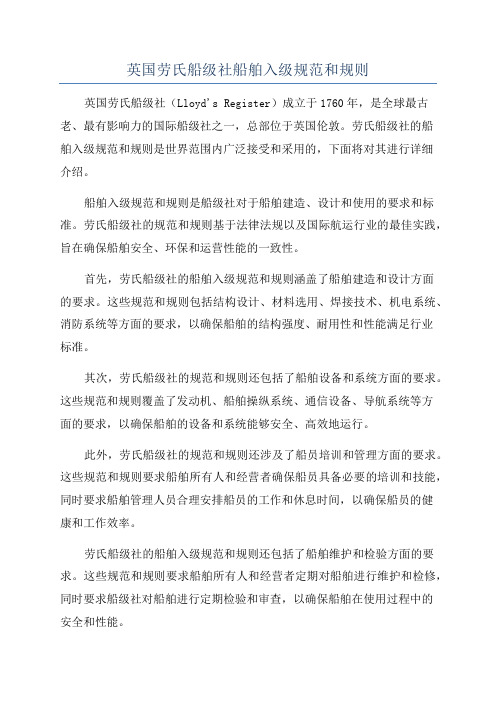
英国劳氏船级社船舶入级规范和规则英国劳氏船级社(Lloyd's Register)成立于1760年,是全球最古老、最有影响力的国际船级社之一,总部位于英国伦敦。
劳氏船级社的船舶入级规范和规则是世界范围内广泛接受和采用的,下面将对其进行详细介绍。
船舶入级规范和规则是船级社对于船舶建造、设计和使用的要求和标准。
劳氏船级社的规范和规则基于法律法规以及国际航运行业的最佳实践,旨在确保船舶安全、环保和运营性能的一致性。
首先,劳氏船级社的船舶入级规范和规则涵盖了船舶建造和设计方面的要求。
这些规范和规则包括结构设计、材料选用、焊接技术、机电系统、消防系统等方面的要求,以确保船舶的结构强度、耐用性和性能满足行业标准。
其次,劳氏船级社的规范和规则还包括了船舶设备和系统方面的要求。
这些规范和规则覆盖了发动机、船舶操纵系统、通信设备、导航系统等方面的要求,以确保船舶的设备和系统能够安全、高效地运行。
此外,劳氏船级社的规范和规则还涉及了船员培训和管理方面的要求。
这些规范和规则要求船舶所有人和经营者确保船员具备必要的培训和技能,同时要求船舶管理人员合理安排船员的工作和休息时间,以确保船员的健康和工作效率。
劳氏船级社的船舶入级规范和规则还包括了船舶维护和检验方面的要求。
这些规范和规则要求船舶所有人和经营者定期对船舶进行维护和检修,同时要求船级社对船舶进行定期检验和审查,以确保船舶在使用过程中的安全和性能。
此外,劳氏船级社的规范和规则还强调了环境保护方面的要求。
这些规范和规则要求船舶在设计和使用过程中符合相关的环保法规要求,同时要求船舶所有人和经营者采取措施减少船舶对环境的影响。
总的来说,英国劳氏船级社的船舶入级规范和规则是船舶建造、设计和使用的权威参考标准,为保障船舶的安全、环保和运营性能发挥了重要作用。
船舶造船和运营者应当遵守这些规范和规则,并与船级社保持密切合作,以确保船舶在全球范围内得到广泛认可和接受。
BalClorTM 压载水管理系统实船应用及管理
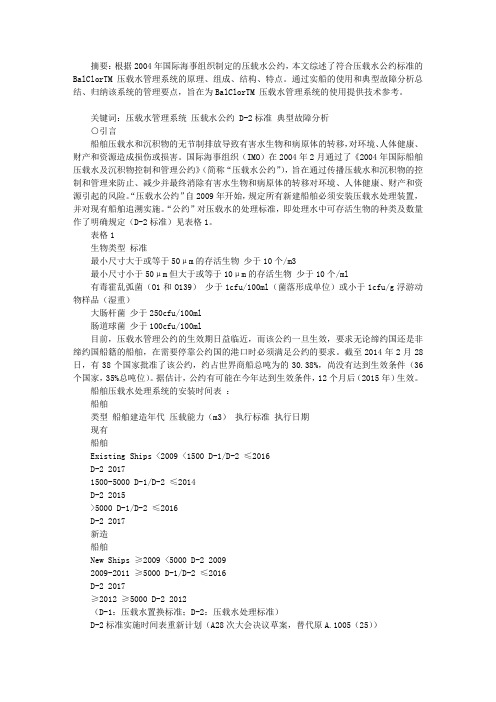
摘要:根据2004年国际海事组织制定的压载水公约,本文综述了符合压载水公约标准的BalClorTM 压载水管理系统的原理、组成、结构、特点。
通过实船的使用和典型故障分析总结、归纳该系统的管理要点,旨在为BalClorTM 压载水管理系统的使用提供技术参考。
关键词:压载水管理系统压载水公约 D-2标准典型故障分析○引言船舶压载水和沉积物的无节制排放导致有害水生物和病原体的转移,对环境、人体健康、财产和资源造成损伤或损害。
国际海事组织(IMO)在2004年2月通过了《2004年国际船舶压载水及沉积物控制和管理公约》(简称“压载水公约”),旨在通过传播压载水和沉积物的控制和管理来防止、减少并最终消除有害水生物和病原体的转移对环境、人体健康、财产和资源引起的风险。
“压载水公约”自2009年开始,规定所有新建船舶必须安装压载水处理装置,并对现有船舶追溯实施。
“公约”对压载水的处理标准,即处理水中可存活生物的种类及数量作了明确规定(D-2标准)见表格1。
表格1生物类型标准最小尺寸大于或等于50μm的存活生物少于10个/m3最小尺寸小于50μm但大于或等于10μm的存活生物少于10个/ml有毒霍乱弧菌(O1和O139)少于1cfu/100ml(菌落形成单位)或小于1cfu/g浮游动物样品(湿重)大肠杆菌少于250cfu/100ml肠道球菌少于100cfu/100ml目前,压载水管理公约的生效期日益临近,而该公约一旦生效,要求无论缔约国还是非缔约国船籍的船舶,在需要停靠公约国的港口时必须满足公约的要求。
截至2014年2月28日,有38个国家批准了该公约,约占世界商船总吨为的30.38%,尚没有达到生效条件(36个国家,35%总吨位)。
据估计,公约有可能在今年达到生效条件,12个月后(2015年)生效。
船舶压载水处理系统的安装时间表:船舶类型船舶建造年代压载能力(m3)执行标准执行日期现有船舶Existing Ships <2009 <1500 D-1/D-2 ≤2016D-2 20171500-5000 D-1/D-2 ≤2014D-2 2015>5000 D-1/D-2 ≤2016D-2 2017新造船舶New Ships ≥2009 <5000 D-2 20092009-2011 ≥5000 D-1/D-2 ≤2016D-2 2017≥2012 ≥5000 D-2 2012(D-1:压载水置换标准;D-2:压载水处理标准)D-2标准实施时间表重新计划(A28次大会决议草案,替代原A.1005(25))船舶建造日期压载水容量(m3) D2标准强制实施日期2009年前 1500-5000 在2014年的交船周年日后的首次换证检验时5000 在2016年的交船周年日后的首次换证检验时2009年及以后但在公约生效前 <5000公约生效后的首次换证检验时2009年及以后但在2012前≥5000 在2016年的交船周年日后的首次换证检验时2012年及以后但在公约生效前≥5000 公约生效后的首次换证检验时压载水系统的选择涉及面广。
- 1、下载文档前请自行甄别文档内容的完整性,平台不提供额外的编辑、内容补充、找答案等附加服务。
- 2、"仅部分预览"的文档,不可在线预览部分如存在完整性等问题,可反馈申请退款(可完整预览的文档不适用该条件!)。
- 3、如文档侵犯您的权益,请联系客服反馈,我们会尽快为您处理(人工客服工作时间:9:00-18:30)。
Ballast Water Management1 Introductionnotes2 Descriptivecriteria3 Assessment4 Information to be submitted■Section 1: IntroductionShipping transfers approximately 3 to 5 billion tonnes of ballast water internationally each year and it is estimated that at least 7,000 different species of aquatic organisms are being carried in ships’ ballast tanks around the world each day.Ballast water is essential to control trim, list, draught, stability, or stresses of a ship, ballast water and may contain aquatic organisms or pathogens. These organisms and pathogens s which on discharge in a port or terminal have the potential to survive and become established and in doing so may pose a threat to indigenous animal and plant life, the marine environment or humans.Although other vectors have been identified as being responsible for transferring organisms between geographically separated water bodies, ballast water discharge from ships is one of the most prominent.In order to avoid the transfer of unwanted aquatic organisms or pathogens in ballast water ships are required to undertake ballast water management. Ballast Water Management is defined as means, mechanical, physical, chemical, or biological processes, either singularly or in combination, to remove, render harmless, or avoids the uptake or discharge of Harmful Aquatic Organisms and Pathogens within Ballast Water and Sediments. In order to manage ballast a ship is required to either carry out ballast water exchange at sea or treat the ballast water to defined standards.1.1 ObjectiveThe Ballast Water Management ShipRight procedure provides a means to indicate to port state, charterers and insurers and other interested parties that a ship has in place ballast water management procedures that have been assessed to a recognised standard that not only complies with the standards in the International Convention for the Control and Management of Ships Ballast Water and Sediments (the BWM Convention) and the applicable associated guidelines but also that the procedures have been assessed for design and safety considerations.In addition the procedure provides a means for complying with the various national and regional ballast water regulations.1.2 ApplicationThis procedure sets down the criteria for assignment of the optional ShipRight descriptive note BWMP. The requirements are additional to other relevant requirements of Lloyd’s Registers Rules and Regulations for the Classification of Ships including the Common Structural Rules.Compliance with any additional requirements that may be imposed by the Administration with whom the ship is registered and/or by the regional, national or local regulations within whose territorial jurisdiction it is intended to operate the ship are the responsibility of the Owner.1.3 Ballast Water Exchange MethodsThe ballast water management method or methods selected for a particular ship is the Owner’s responsibility. The method selected must be one or a combination of the three IMO recognised ballast water exchange methods, i.e. sequential, flow through or dilution method.All methods of ballast water exchange and treatment have advantages and disadvantages, and associated safety issues. When deciding on a particular method or combination of methods of ballast water exchange for a particular ship the safety issues associated with the method selected for the ship or tank and those associated with the ship are to be taken into account.For new ships, as far as is practicable the design is to be such that ballast water exchange is facilitated and that the safety issues associated with the exchange method or methods to be use are minimised.For existing ships account is to be taken of any modifications that may be required or considered necessary in order to facilitate ballast water exchange and the safety issues associated with the exchange method or methods to be used minimised.Any installed or modifications to structural and piping arrangements may require approval for compliance with the applicable Rules and Regulations.■Section 2: Descriptive notes2.1 BWMP descriptive notesShips complying with this Procedure will be eligible to be assigned the BWMP descriptive note together with one, or a combination of the following associated supplementary characters dependant upon the method or methods of ballast water management used onboard provided that the applicable criteria in Section 3 are complied with.The eligible ballast water management methods are as follows:Sequential method (S)a process by which a ballast tank intended for the carriage of ballast water is first emptied and then refilledwith replacement ballast water to achieve at least a 95 per cent volumetric exchange.Flow-through method (F)a process by which replacement ballast water is pumped into a ballast tank intended for the carriage of ballastwater, allowing water to flow through, overflow or other arrangements.Dilution method (D)a process by which replacement ballast water is filled through the top of the ballast tank intended for thecarriage of ballast water with simultaneous discharge from the bottom at the same flow rate and maintaining a constant level in the tank throughout the ballast exchange operation.Treatment method(T)a ballast water treatment system approved in accordance with regulation D-3 of the BWM Convention. Example:ShipRight BWMP (S) indicates that the ship uses the sequential method.ShipRight BWMP (S+F) indicates that the ship uses the sequential and the flow-through methods combined. Lloyd’s Register is to be advised of any modifications to the ballast water system or the ballast water management plan that that does or may effect compliance with these procedures and that may affect the assignment of the ShipRight BWMP descriptive note.■Section 3: Acceptance criteriaRequirements3.1 GeneralIt is a prerequisite of this procedure that the ship has a Ballast Water Management Plan that has been developed in accordance with and found to comply with the requirements of regulation B-1 of the Convention and the International Maritime Organisations (IMO) - Guidelines for Ballast Water Management and Development of Ballast Water Management Plans MEPC.127 (53). In addition for ships using ballast water exchange the IMO Guidelines for Ballast Water Exchange MEPC.124(53) are to be taken into account when developing the plan.The Lloyd’s Register Model Ballast Water Management Plan can be used for the preparation of the plan. At the specific request of the Owner, or the Shipbuilder a ballast water management plan can be prepared by Lloyd’s Register.Where a new Ballast Exchange sequence is to be introduced in an existing ballast water management plan, the new sequence must be submitted to Lloyd’s Register for review and approval, as necessary.The ballast water management plan is to contain one or more ballast water exchange sequences in a format similar to the example in Appendix 1. The ballast water exchange sequences are to indicate for each sequence, at the start of the sequence, at the end of the sequence and at intermediate stages of each sequence including the worst case for each of the following:•Longitudinal strength. Checks against the assigned permissible still water bending moments and shear forces, see 3.2.•For bulk carriers, the longitudinal strength assessment for hold flooded conditions need not be carried out during the exchange sequences.•Intact stability, where required checks against the required values as indicated in the stability booklet. The effects of the combined free surface moments are to be considered, see 3.2.•Ballast inertia. For new construction, ballast inertia aspects of bulk carriers are to be considered according to the ShipRight Structural Design Assessment Procedure when applicable. For bulk carriers in service, ballast inertia aspects are to be considered using maximum lifetime accelerations and assuming a 100% filling level of theballast hold with adjacent topside and/or hopper tanks empty, as submitted in the BEP, or the acceptable sea state is to be defined.•Sloshing Where deemed necessary by Lloyd’s Register or at the owners request, sloshing aspects are to be considered according to the Rules for Ships and the ShipRight Structural Design Assessment Procedure Sloshing Loads and Scantling Assessment.•Minimum draught forward c hecks against the minimum draft forward as indicated in the ship’s plans and/or loading manual. Where not otherwise defined, this is to be taken as 0,045L or as the draught forward of anapproved condition.•Propeller immersion. Checks that at all stages of any exchange sequence the top dead centre of the propeller will remain below the still waterline.When the propeller immersion criterion can not be satisfied during an entire ballast sequence a note is to be included in the ballast water management plan in the section dealing with ‘Operational or Safety Restrictions’ as follows “the Master is advised that the propeller will not be fully immersed during some stages of ballast water exchange”. In addition in the appropriate sequence in the Ballast Exchange Sequences a similar note is also to be made against the ballast exchange sequence(s) where full propeller immersion is can not be achieved.Bridge visibility forward. Checks that bridge visibility is maintained in accordance with SOLAS V/22.It is recognised that not all ships in service comply with SOLAS 1974, Chapter V Safety of Navigation Regulation 22 Navigation bridge visibility.Where bridge visibility can not be maintained at all stages of an exchange sequence a note inserted in the ballast water management plan in section dealing with ‘Operational or Safety Restrictions’ that the Master is advised that where the bridge visibility criterion in SOLAS V/22 can not be complied with during some or all stages of the exchange sequences the Master is to take due account of the guidance given in section 5.5 to 5.8 of IMO resolution MEPC.124(53) and in addition with effect from1 January 2010 to comply the revised SOLAS V/22 as adopted by the IMO in resolutionMSC.202(81).3.2 Assessment of Longitudinal Strength, bending moments and shear forces and intact stabilityAt all times during ballast water exchange the shear forces and bending moments and intact stability criteria are to be within the limits stated in the approved loading manual and/stability booklet.It is not a condition of assignment of the BWMP notation that all ships undertaking ballast water exchange have onboard a loading instrument approved for Longitudinal Strength, bending moments and shear forces and intact stability however it is preferable.For a loading instrument to be accepted as approved it is to meet the following criteria:The ship has the class notation LI or the descriptive note LI or where the entry “Loading Instrument (C)” or “Loading Instrument” appears in the Hull Memoranda. A loading instrument approved for the calculation of Longitudinal Strength, bending moments and shear forces may also be accepted.If the ship has a stability and/or longitudinal strength calculation program or module has not been accepted or certified by Lloyd’s Register there is an option to have the stability and/or longitudinal strength calculation program or module certified in accordance with standards acceptable to Lloyd’s Register.Flow Through Method. Strength and Stability Approval is not normally required when the flow through method is the only method used. However when for example a peak or other tank that is normally partially filled is required to be pumped up for exchange purposes using the flow through method and then discharged to the normal partially filled level on completion approval of longitudinal Strength, bending moments and shear forces and intact stability maybe required.Dilution Method. Strength and Stability Approval is not normally required when the dilution method is the only method used.Flow through and Dilution Methods Combination. Strength and Stability Approval is not normally required, except where for example a peak or other tank that is normally partially filled is required to be pumped up for exchange purposes and then discharged to the normal partially filled level on completion.Sequential Method. When the sequential method is used, or is used in combination with flow through or dilution method,approval of longitudinal strength, bending moments and shear forces and intact stability for each ballast water exchange sequence will be required. Where a ship has a loading instrument approved for strength and stability Lloyd’s Register may accept the results from a loading instrument approved for longitudinal strength, bending moments and shear forces and intact stability in lieu of the above. Where the loading instrument is approved for longitudinal strength, bending moments and shear forces only, Lloyd’s Register may accept the results from a loading instrument for these aspects however approval of intact stability for each exchange sequence will be required.3.3 Assessment criteria for each methodIn addition to the general requirements in 3.1 and 3.2 the following criteria will be assessed for assignment of the relevant ShipRight descriptive note. Refer to Section 4 for details of the plans and information to be submitted.3.3.1 ShipRight BWMP (T)For the assignment of the ShipRight BWMP(T) descriptive note the criteria given in this section are to be satisfied.The installed ballast water treatment system is to be approved in accordance with the IMO Guidelines for Approval of Ballast Water Management Systems MEPC.125(53) as may be amended or;The installed ballast water treatment system is a prototype treatment system installed and under a programme approved by the Administration in accordance with regulation D- 4 of the Convention and has been or is undergoing approval inaccordance with in accordance with the IMO Guidelines for Approval and Oversight of Prototype Ballast Water Treatment Technology Programmes MEPC.140(54).3.3.2 ShipRight BWMP (F)For the assignment of the ShipRight BWMP (F) descriptive note the criteria given in this section are to be satisfied.New construction:The scantlings of the tank boundary structure are to be determined using a tank head equivalent to the full distance to the top of the tank excluding hatches, but not less than the distance to the deck at the side on which the overflow pipe is fitted.Where the overflow discharge pipe is fitted below the freeboard deck, the head is to be taken not less than the full distance to top of the discharge pipe or the distance to the ship operating draft, whichever is greater.For applicable formulations, see Pt 4, Ch 1 and Table1.9.1 of the Rules for Ships, for deep tank and watertight bulkheads in general. For double hull oil tankers, Pt 4, Ch 9, Table 9.6.1 for inner hull and longitudinal oil tight bulkheads remains applicable. For oil tankers and bulk carriers where the Common Structural Rules (CSR) are applicable CSR Oil Tankers Section 8 paragraph 2.5 or CSR Bulk Carriers Chapter 6 Sections 1 and 2 apply.Ships in service:The flow-through method is not to be utilised, unless the tank boundary structure has been confirmed as being acceptable using a tank head as defined for new construction above, and any structural modifications found necessary have been carried out. For applicable formulation, see Pt 4, Ch 1, Table 1.9.1 of the Rules for Ships for deep tank bulkheads in general. For double hull oil tankers, Pt 4, Ch 9, Table 9.6.1 for inner hull and longitudinal oil tight bulkheads remains applicable. For oil tankers and bulk carriers where the Common Structural Rules (CSR) are applicable CSR Oil Tankers Section 8 paragraph 2.5 or CSR Bulk Carriers Chapter 6 Sections 1 and 2 apply.It is not permitted to connect ballast tanks, which were not previously connected, unless the tank boundary structure is checked and found satisfactory or any necessary structural modifications are carried out.All cases:The flow-through method will only be accepted for partially filled peak tanks, provided that inadvertent exceedance of the design partial filling levels will not result in hull girder bending moments and shear forces or stability criteria exceeding the permissible values.At the specific request of the Owner, Lloyd’s Register can calculate the pressure drop of the pipework and match it to the ballast pump capacity curve.The following recommendations are to be complied with as far is reasonable and practicable:Inlet and outlet piping connections to be located as far apart as practicable, in order to improve circulation.A larger discharge pipe located in a remote position opposite from the filling pipe and a smaller discharge pipe is to be located in a position closer to the filling pipe, to improve circulation.The total sectional area of the ballast water discharge pipes is to be arranged to be not less than two times the sectional area of the filling pipe, in order to mitigate the risk of overpressure.The use of two ballast pumps simultaneously is not recommended due to the risk of overpressure, unless the system is designed for the simultaneous use of two pumps.Distribute one ballast pump to several tanks, in order to mitigate the risk of overpressure.Where overflow pipes are fitted to hatch coamings, it is recommended that they are fitted to the side coaming with a closing plate hinge arrangement and to be arranged to discharge downward.Manholes on upper deck may be used as overflow discharge, provided that a blank flange with a seat can fitted to the manhole cover arranged so that a portable overflow pipe with 90° elbow can be connected during the flow-through operation to direct the water away from the deck.Ballast water is not to be discharged from an air pipe head with float type closing appliance, unless a blank flange with a short distance piece is fitted below the air pipe head, which is to be removed during the flow-though operation.3.3.3 ShipRight BWMP (S)For the assignment of the ShipRight BWMP (S) descriptive note, the criteria given in this section are to be satisfied.The following are to be complied with:Ballast holds and large ballast tanks are to be equipped with pressure/vacuum valves or other means acceptable to Lloyd’s Register, in order to mitigate the risk of a large drop in pressure, due to the rapid change in the contents of the tank during ballast discharge by gravity. Pressure/vacuum valves valves, where fitted, are to be maintained in good working order, as a faulty pressure/vacuum valve for example by being blocked or failing to lift may result in hatch cover damage.During the intermediate stages of ballast water exchange, the machinery’s operating design characteristics (angles of inclination) are not to be exceeded.In addition the following recommendations are to be complied with as far is reasonable and practicable:If two ballast pumps are used for filling purposes the ballast water management plan is to contain a note that, when the fill level reaches 80–90 per cent, one of the pumps is to be stopped, in order to mitigate the risk of over-pressurisation.Where operational limits are specified, at least two independent pumps are to be fitted. The pumps are to be arranged such that, if one pump fails, then the stand-by pump is immediately available for operation.Sequences with partial fill level are to be avoided. Where at the end of a sequence a tank remains partially filled, conditions at ±10 per cent of the partial fill level are also to be assessed, since it is practically difficult to match the specified partial fill level whilst ship motions are experienced.Exchange sequences are to be developed such that the still water bending moments and shear forces do not exceed 85% of the permissible values, in order to account for small deviations in service.3.3.4 ShipRight BWMP (D)For the assignment of the ShipRight BWMP (D) descriptive note the criteria given in this section are to be satisfied. Where the dilution method of exchange is used adequate provisions are to be made for appropriate pumping and piping arrangements to facilitate simultaneous loading and unloading of ballast water at the same flow rate.Arrangements are to be made to continually monitoring of the ballast water level in the tanks to ensure a constant level is maintained to avoid the possibility of overfilling the tank or reducing the level in the tank.■Section 4: Information to be submitted4.1 GeneralThe following plans and information are to be submitted in all cases:(a) A copy of an approved ballast water management plan meeting the requirements in Section 3.1; or(b) a plan to be approved by Lloyd’s Register to meet the requirements of 3.1, a minimum of two copies are to besubmitted Lloyd’s Register will retain one copy of the ballast water management plan.(c) Ballast pumping and piping arrangements.(d) Air and sounding pipes arrangements.(e) Specifications and capacity curves for ballast pump and general service pump, if used for ballast transfer.(f) General arrangement and capacity plan.(g) Ballast tank and pump capacities and estimated emptying and refilling times.(h) A copy of the approval certificate for the loading instrument.(j) A copy of the ships approved loading manual.4.2 Specific requirements for the ballast water management options defined in Section 3In addition to the plans and information in 4.1:(a) For the assignment of ShipRight BWMP (T):A certificate confirming the system has been approved in accordance with in accordance with the IMO Guidelinesfor Approval of Ballast Water Management Systems MEPC.125(53) as may be amended issued by a flagadministration signatory to the Convention or by Lloyd’s Register or by a member of the International Association of Classification Societies issuing the approval certificate on behalf of a flag administration signatory to theConvention.Approved plans or diagrams of the treatment system installation, and arrangements including piping systems, connections to the ballast system, treated ballast water outlet points and sampling point(s).(b) For the assignment of ShipRight BWMP (F):For bulk carriers confirmation that that the topside and hopper tanks are or are not interconnected.(c) For the assignment of ShipRight BWMP (S):For ships in service, for the assessment of ballast inertia: approved midship section with end connection details, ballast hold volume data or curves, metacentric height, service speed and block coefficient.4.3 Optional Assessment CriteriaWhere Lloyd’s Register, at the specific request of the Owner, is to certify the stability and/or longitudinal strength calculation program or module, the information required by Lloyd’s Register’s document entitled Approval of Longitudinal Strength and Stability Calculation Programs is to be submitted.Where Lloyd’s Register, at the specific request of the Owner, is to calculate the pressure drop of the pipework and match it to the ballast pump capacity curve, the following information is to be submitted:Ballast supply piping dimensions.Overflow pipe length and size.Piping components fitted to the ballast supply line, i.e. bends, T-connections, type and number of valves.Pump capacity curve.Air vent head flow capacity curve.4.4 ModificationsPlans and particulars of proposed modifications to the ballast system or other modification to the ship which may affect the BWMP descriptive note assigned to the ship are to be submitted for approval before any work commences and the work is to be carried out in accordance with the approved plans to the Surveyor’s satisfaction.Ballast Water Management 2009/01Lloyd’s Register 10Appendix 1 Example Ballast Exchange Sequence TableAllowable limitsMin fwd draftStab’ CriteriaMax allowa ble SW BM MAX allow SW SFProp fully immers at Voyage : From: To:Expected weather:M %%MActual ValuesFo/Do/L o/Fw MtDraft Aft M Trim MDraft Fwd Stab’ CriteriaSW BM %SW SF % Prop. Immer %.InvisLe ngth MEst’ed Time Hours RemarksSequenceAP Tank No Tank No Tank No Tank No Tank No Tank No Tank No F.P.TInitial ConditionStep 1:Step 2:Step 3:Step 4:Total Time HoursBallast Water Management 2009/01Lloyd’s Register 11 The colouring of the cells where the criteria are not satisfied can enhance understandingAbbreviationsES - Empty at startFS - Full at startFL - FillingD - DischargingFE - Full at endEE - Empty at endX% - Percentage fullPercentage of tank level or symbols such as those presented below may be used asnecessary where greater detail is required , additional symbols can be defined Notes Examples Note 1: The master is advised that the propeller will not be fully immersed during this step/sequence Note 2: The master is advised that bridge visibility forward will be reduced during this step/sequence Note 3 The master is advised to verify that tanks shown as "e" or "e" are totally empty and tanks shown as "f" or "f" are totally full, at the start and end of the step/sequence Note 4: Where two ballast pumps are used for filling purposes, when the full level reaches 80% - 90%, then one of the pumps is Note 5: The indicative times for ballast exchange by flow-through method of …tanks(s) id…are provided separately For conservative reasons, where at the end of a step / sequence a tank remains partially filled, additional conditions at ± 10 % of the partial fill level are also be assessed, since it is practically difficult to match the specified partial fill level whilst ship motions are experienced Aim to develop sequences where the still water bending moments and shear forces do not exceed 85% of the permissible values, in order to account for small deviations in service, so that the master and the appointed ballast water。
